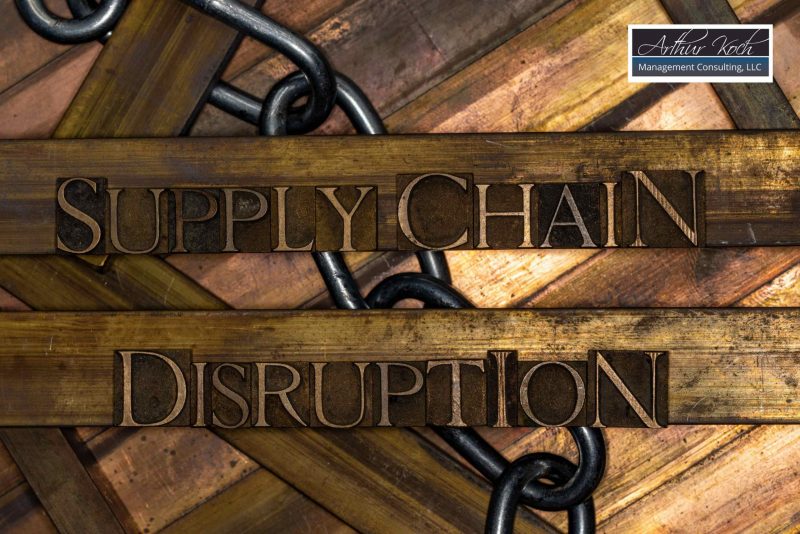Avoiding Supply Chain Disruptions
August 26, 2021Art Koch’s Profit Chain® Series
Volume 4 | Number 7 | August 2021

A colleague of mine recently joined a new company as their CEO. During the first few weeks on the job, she performed due diligence on the current situation. She quickly realized the severity of disruptions engulfing worldwide supply chains and the potential negative impact on the company’s profits.
Leaders from critical areas of the company arranged a strategy session following discussions with the CEO. The meeting comprised finance, human resources, engineering, quality assurance, manufacturing, and of course, team members from supply chain management.
The title of the meeting invitation was “Supply Chain Disruptions.” During introductions, I could sense feelings of frustration from meeting participants.
The first challenge was to get every team member to accept that the supply chain is not just one department. A resilient supply chain results from an entire enterprise’s efforts to improve responsiveness, flexibility, and predictability to customers.
The second challenge was to address team members from supply chain management suffering defeatism. Unfortunately, prior leadership had not listened to the VP of Supply Chain’s concerns regarding the risk associated with a far-reaching supply base, current staffing skills, and supply chain process ownership. However, once we dove into a brainstorming exercise and identified stretch yet realistic opportunities, most team members’ attitudes shifted to a more positive stance. They realized, “Yes, we can accomplish this!”
Most importantly, the brainstorming session “zeroed in” on lead-time as one of the most significant contributors to responsiveness, flexibility, and predictability.
The number one action that must be taken to avoid supply chain disruptions is to reduce lead time.
We then dove deeper into the factors that affect lead time. Procurement can reduce lead times by initiating the following measures:
- Ask and challenge suppliers on their current lead times.
- If suppliers are delivering quicker than system lead times, reduce lead times accordingly.
- If a part is commercially available, using a distributor typically reduces the total cost of ownership, including lead time.
- Give suppliers an extended range forecast of six, nine, or twelve months of demand, which helps them plan their business going forward.
- Implement raw material, work-in-process, and finished goods authorizations with suppliers. This methodology, when applied effectively, reduces total inventory purchasing exposure, pipeline inventory and shrinks lead times so that they can become as short as transit time.
The first four of these area initiatives are relatively simple to implement. It only takes leadership support, initiative, and perseverance. Keep in mind many small and medium incremental wins will amount to significant long-term success. The fifth directive is a little more challenging to implement. However, when combined with distribution solutions and twelve-month forecast horizons, they will transform your supply chain into a much more responsive, flexible, and predictable competitive advantage. After completing the brainstorming exercise, I would like to add that the procurement team’s body language and facial expressions turned positive as they could finally “wrap their heads” around the tasks and goals at hand!
Next, we uncovered opportunities to reduce the lead time within operations by resourcing, nearshoring, reshoring, or insourcing the supply chain. Initially, several team members believed that 100% of the company’s issues pertained to supply chain management until we identified factors that contribute to determining lead times from each discipline. After just a few minutes, the group came to understand that this was a comprehensive enterprise challenge.
Procurement, Quality Assurance, and Supplier Quality Engineering identified commodities that could be easily resourced. Engineering, Supplier Quality Engineering, Manufacturing Operations, and Human Resources identified several product families that could be insourced.
Senior leadership became responsible for implementing critical action plan elements, milestone dates, and status update cadence.
During one brainstorming session, the team achieved a sense of urgency and organizational focus on:
- Reducing and eliminating supply chain disruptions.
- The realization that by not working together as an enterprise, we leave ourselves vulnerable to competition.
- A consensus that anything can be achieved when harnessing the entire organization’s skills, focus, and sense of urgency.
- Reducing lead times and supplier disruptions improves responsiveness, flexibility, and predictability to customers.
Categorized in: Art Koch Profit Chain® Tips
